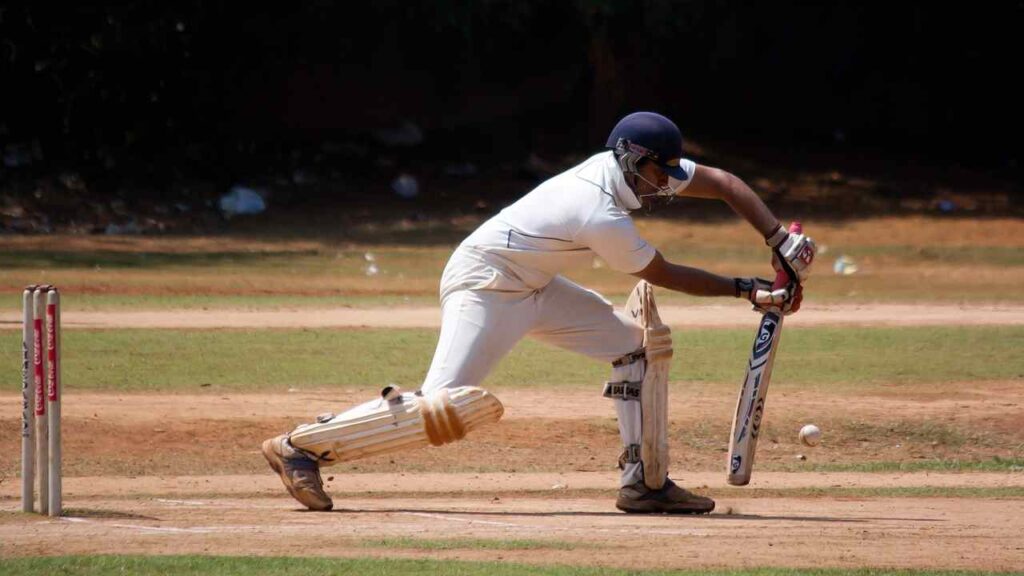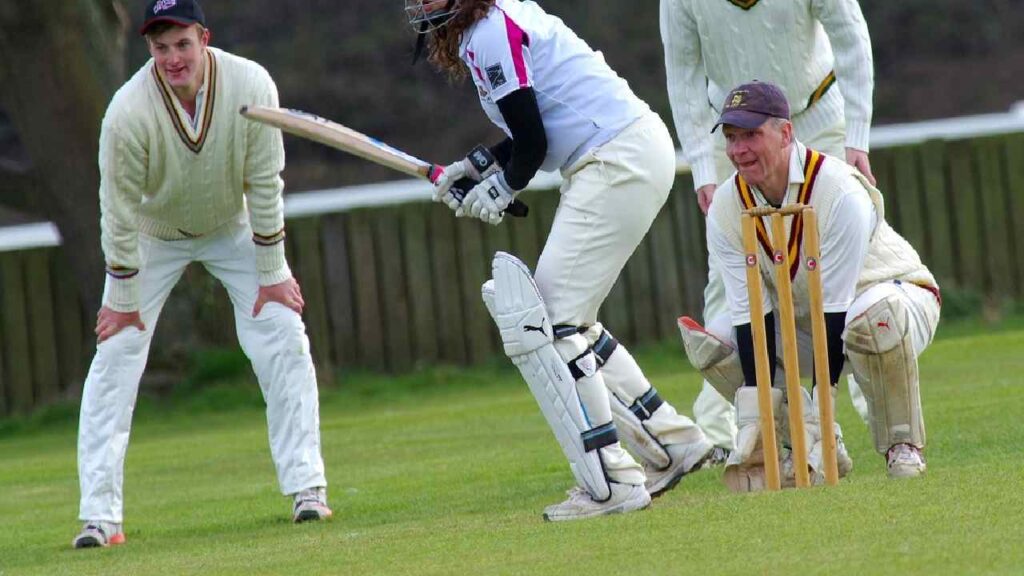Cricket is a thrilling sport of bat and ball, played and loved by millions around the world. Whether it’s international matches, local tournaments, or even a friendly game of gully cricket, people of all ages enjoy the excitement the game brings. To truly understand and appreciate cricket, it’s important to familiarize yourself with the various cricket jargons and terminologies in cricket. In this article, we’ll break down the 10 terminology of cricket, from batting and bowling to fielding and umpiring, making it easier for you to speak the language of cricket with confidence
Toss
The process by which the two captains, along with the match referee, flip a coin before the match to decide which team bats or bowls first. The captain who wins the toss has the option to choose whether to bat or bowl.
10 terminology of cricket – Batting

Let’s see commonly used 10 terminology of cricket in batting.
- Duck
A term used when a batsman gets out without scoring any runs. Similarly, we have term Golden Duck which means batsman gets out on first ball. - Sixer
A hit that crosses the boundary without touching the ground, awarding the batsman six runs. - Boundary
A boundary can be of two types:- A four is when the ball hits the ground before crossing the boundary line.
- A six is when the ball crosses the boundary without touching the ground.
- Century
When a batsman scores 100 or more runs in a single innings. This is a huge milestone for any player. - Strike Rate
A measure of how fast a batsman scores, calculated as the number of runs scored per 100 balls faced. - Leg Before Wicket (LBW)
A method of dismissal when the ball hits the batsman’s leg in line with the stumps, and it would have gone on to hit the stumps. - Sweep Shot
A cross-batted shot, typically played to a delivery on the leg side, where the batsman sweeps the bat in a horizontal arc. - Square Cut
A shot played on the off-side, where the batsman cuts the ball square to the boundary, typically to a short-pitched delivery. - Pull Shot
A shot played on the leg side, typically to a bouncer or a short-pitched delivery, where the batsman pulls the ball to the boundary. - Hook Shot
A shot like the pull shot but played to a delivery that is much higher and aimed at the batsman’s head or chest. - Drive
A shot played along the ground, usually with a straight bat, aimed at the gaps in the field. Common types include the cover drive and on-drive. - Cut Shot
A horizontal shot played on the off-side, often to a short-pitched delivery, where the batsman cuts the ball square or behind the wicket.
10 terminology of cricket – Bowling

Let’s see commonly used 10 terminology of cricket in bowling.
- Yorker
A delivery aimed at the batsman’s feet, making it difficult to hit. Often used in the death overs. - Bouncer
A short-pitched delivery that bounces high, typically aimed at the batsman’s head or chest. - Googly
A deceptive delivery from a leg-spinner that turns in the opposite direction to what the batsman expects. - Swing Bowling
The movement of the ball in the air, either away from or towards the batsman. It can be induced by the condition of the ball and the way it is bowled. - Seam Bowling
When the bowler uses the seam of the ball to create movement off the pitch. This type of bowling relies more on the pitch conditions. - Dot Ball
A ball in which no runs are scored. It’s a significant achievement for the bowler, especially in limited-overs cricket. - Wicket Maiden
A maiden over (an over with no runs conceded) in which the bowler also takes a wicket. - Full Toss
A ball that reaches the batsman without bouncing, often at waist height or higher. - Out Swinger
A ball that moves away from the batsman (for a right-handed batsman, it moves from the off side to the leg side). - In Swinger
A ball that moves into the batsman (for a right-handed batsman, it moves from the leg side to the off side). - Off Cutter
A delivery that spins from the off side to the leg side, typically bowled by fast bowlers. - Hat-Trick
When a bowler takes three wickets in consecutive deliveries.
10 terminology of cricket – Fielding

Let’s see commonly used 10 terminology of cricket in fielding.
- Catch
When a fielder catches the ball on the full after the batsman hits it, resulting in the batsman’s dismissal. - Run Out
A player is run out when the fielding side hits the stumps with the ball in hand before the batsman reaches to the crease. - Stumping
A dismissal that occurs when the wicketkeeper removes the bails while the batsman is out of his crease and not attempting a run. - Slips
A fielding position behind the batsman on the off side, used for catching balls that are edged by the batsman. - Third Man
A fielding position behind the batsman on the off side, close to the boundary. - Fine Leg
A fielding position behind the batsman on the leg side, near the boundary. - Square Leg
A fielding position on the leg side, standing square to the batsman. - Deep Mid-Wicket
A fielding position on the leg side, typically used for defending against powerful shots over the leg side. - Long On
A fielding position on the leg side, usually placed near the boundary to intercept powerful shots. - Mid-Off
A fielding position on the off side, typically a short to mid-distance from the bowler. - Short Leg
A fielding position close to the batsman on the leg side, used to catch balls off the batsman’s pads or to a short-pitched delivery. - Gully
A fielding position behind the batsman on the off side, placed between the slips and point.
10 terminology of cricket – Umpiring
Let’s see commonly used 10 terminology of cricket in umpiring.
- Out
When the umpire declares a batsman as dismissed, using a raised finger or other methods, depending on the situation. - Not Out
When the umpire decides the batsman has not been dismissed and continues their innings. - No-Ball
An illegal delivery by the bowler, such as overstepping the crease or delivering a high full-toss. It leads to an extra run and the delivery being re-bowled. - Wide
A delivery that is too far from the batsman’s reach, resulting in an extra run and a re-bowled delivery. - Free-Hit
A delivery following a no-ball in which the batsman cannot be dismissed in most ways, except by being run out or hitting the ball twice. - Third Umpire
The official who reviews decisions made by the on-field umpires, typically through video technology like DRS. - Decision Review System (DRS)
A technology-driven system that allows players to challenge on-field umpire decisions. It includes ball-tracking and video replays. - Leg Bye
A run taken while the ball hits the batsman’s body, but not the bat, and does not result in a dismissal. - Dead Ball
When the ball is declared to be no longer in play, usually after a wide, no-ball, or when a fielder has interfered. - Front Foot No-Ball
A no-ball called if the bowler oversteps the crease with their front foot. - Duckworth-Lewis Method
A mathematical formula used to calculate the target score in rain-affected matches.
Conclusion
Cricket is a game full of unique and fascinating terms that reflect its complexity and strategic depth. Understanding these jargons will not only help you appreciate the game more but will also allow you to follow matches with greater understanding. Whether you’re watching a T20, ODI, or Test match, knowing the terminology will enrich your cricket experience.
Stay tuned for more cricket-related content, and feel free to explore deeper into the language of cricket with these terms. Happy Cricketing!

